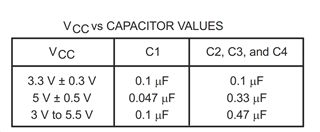Other Parts Discussed in Thread: MAX3243E
Dear Team,
Please refer to attachment, "UBS-240_MAX3221E Schematic Review.pdf".
Could you help to provide review it? Thanks a lot.
UBS-240_MAX3221E Schematic Review.pdf
Many Thanks,
Jimmy
This thread has been locked.
If you have a related question, please click the "Ask a related question" button in the top right corner. The newly created question will be automatically linked to this question.
Dear Team,
Please refer to attachment, "UBS-240_MAX3221E Schematic Review.pdf".
Could you help to provide review it? Thanks a lot.
UBS-240_MAX3221E Schematic Review.pdf
Many Thanks,
Jimmy
Hi Jimmy,
One note - If VDD = 3.3V then I don't see any issue.
However if VDD =/= 3.3V then please refer to table below:

Clemens is also correct - the MAX3243E could also work to meet similar design goals without needing to use 3 IC's when a single chip solution is possible. For the unused Receiver ports (RIN) on the MAX3243E - you can just pull them up to VCC (as long as the only connection is unused RIN to VCC) as a 0V level puts device state as indetermite - where pulling the RIN pins to VCC keeps a valid level - and you can just leave unused ROUT floating.
Please let me know if you have any other questions!
Best,
Parker Dodson.
The bus inputs already have internal pull-down resistors; unused RIN pins should be left open.
Technically speaking by RS-232 standard 0V is undefined; a logic zero is valid from 3V to 15V and a logic 1 from -3V to -15V.
If you leave the RIN input floating - while it is pulled down internally so the ROUT level will be constant because this device does not meet the standard receiver sensitivity- the signal is invalid and the /INVALID output will be forced low the entire time during operation - even if you do have valid data.
This limits the parts usability as a major feature was ruined by that design choice - if you hook unused RIN inputs to VCC this no longer becomes an issue because the unused channels sees "valid" data.
So yes you can leave RIN floating, but you are reducing functionality and flexibility of device when you do that (and are paying for a feature that you don't use - but you will still pay for it). So for generic systems its not wise to say just leave "RIN" floating - because that assumption does not apply to all cases whereas logically pulling unused RIN to at least VIT+(max) keeps the device more flexible as you aren't preventing actual functionality of the device in this setup.
Parker Dodson